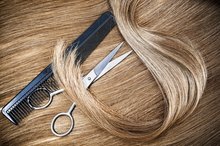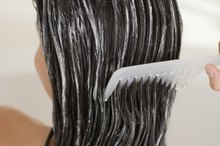Hair Breakage Symptoms
Hair might break at the ends, making it appear frayed and frizzy, or closer to the crown, making hair look thin or ragged. If your hair is breaking, it may be the result of frequent hair coloring or perming, heat styling tools like blow dryers and hair straighteners, or swimming in chlorinated water.
Hair Feels Gummy
When healthy hair is wet, it feels smooth and glossy. When damaged hair that is prone to breakage is wet, it can feel gummy or sticky to the touch. Hair that feels gooey is damaged and may break off. Individuals with sticky-feeling hair should not dye or perm their hair, swim in chlorinated water, or use heated styling products. Sticky, gummy hair will break if much more damage is done.
Hair Gets Tangled Easily
How to Restore Hair Elasticity
Learn More
Hair prone to breakage may feel frayed or like straw, and these coarse strands can get tangled more easily than hair that still contains sebum, the natural oil in hair. Although hair may become tangled, KidsHealth suggests brushing hair only when it is dry, because hair breaks more easily when it is wet 1. To avoid hair breakage while brushing or combing your hair, use a moisturizing conditioner after shampooing and spray with a detangler before brushing hair out when it is completely dry.
- Hair prone to breakage may feel frayed or like straw, and these coarse strands can get tangled more easily than hair that still contains sebum, the natural oil in hair.
Hair Elasticity
Hair breakage may occur in hair that's brittle when dry and stretchy when wet. To determine whether overprocessing has compromised the strength of your hair, pull a piece of hair from your scalp and submerge it in water. After removing it from the water, pull gently on each end of the hair. It will either break, stretch or stay intact. If hair breaks or stretches, it is unhealthy. If the hair stays intact, it is strong and healthy.
- Hair breakage may occur in hair that's brittle when dry and stretchy when wet.
- To determine whether overprocessing has compromised the strength of your hair, pull a piece of hair from your scalp and submerge it in water.
Hair Dries Slowly
Can I Repair Chemically Treated Hair Loss?
Learn More
Hair prone to breakage may not dry as quickly as hair that is healthy, due to lack of protein and and moisture in the hair. Hair will try to retain moisture, making it stay wet longer. Even if your hair takes longer to dry than usual, avoiding blow drying or using heat to prevent it from becoming more damaged. The healthiest way to maintain damaged hair is to avoid styling products and hair color until hair grows out completely.
- Hair prone to breakage may not dry as quickly as hair that is healthy, due to lack of protein and and moisture in the hair.
Related Articles
References
- KidsHealth.org: Taking Care of Your Hair
- American Society of Clinical Oncology. Hair loss of alopecia. Updated August, 2018.
- Saed S, Ibrahim O, Bergfeld WF. Hair camouflage: A comprehensive review. Int J Womens Dermatol. 2017;3(1 Suppl):S75–S80. Published 2017 Feb 16. doi:10.1016/j.ijwd.2017.02.016
- Dua P, Heiland MF, Kracen AC, Deshields TL. Cancer-related hair loss: a selective review of the alopecia research literature. Psychooncology. 2017;26(4):438-443. doi:10.1002/pon.4039
- National Cancer Institute. Hair loss (alopecia) and cancer treatment. Updated January 15, 2020.
Writer Bio
Megan Smith has been a freelance writer and editor since 2006. She writes about health, fitness, travel, beauty and grooming topics for various print and Internet publications. Smith earned a Bachelor of Fine Arts in writing from New York University.









